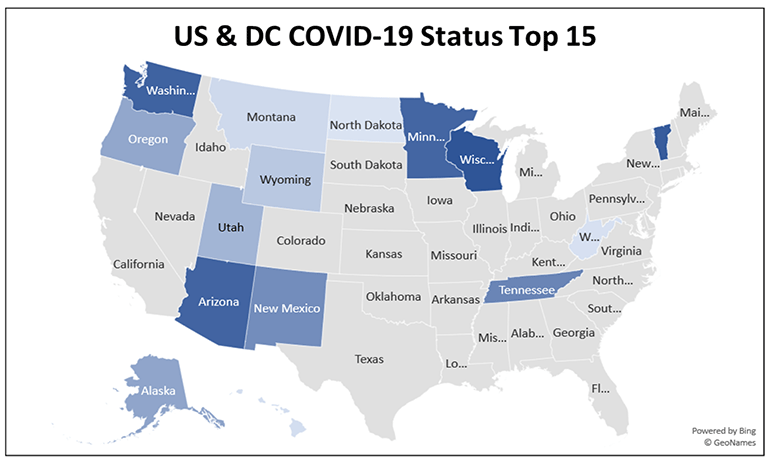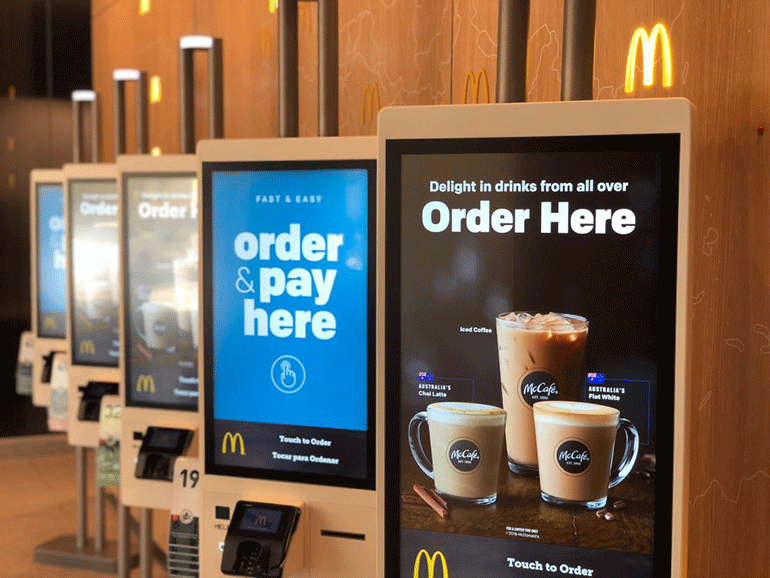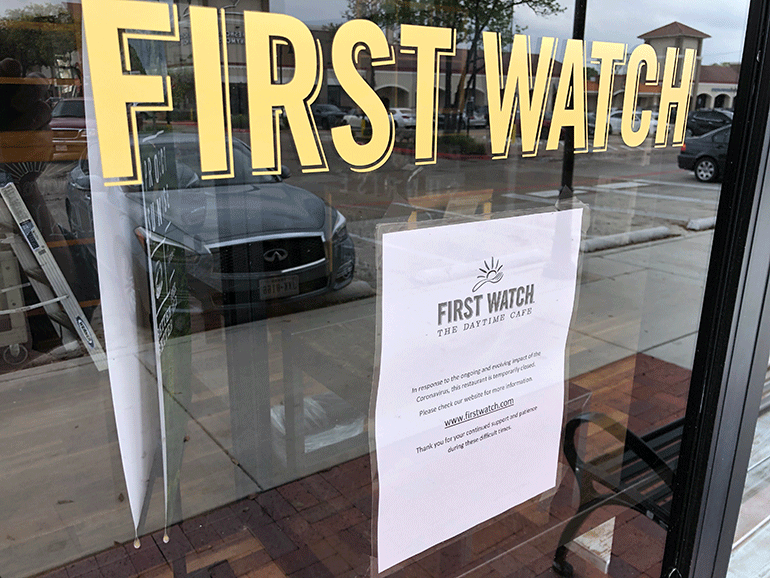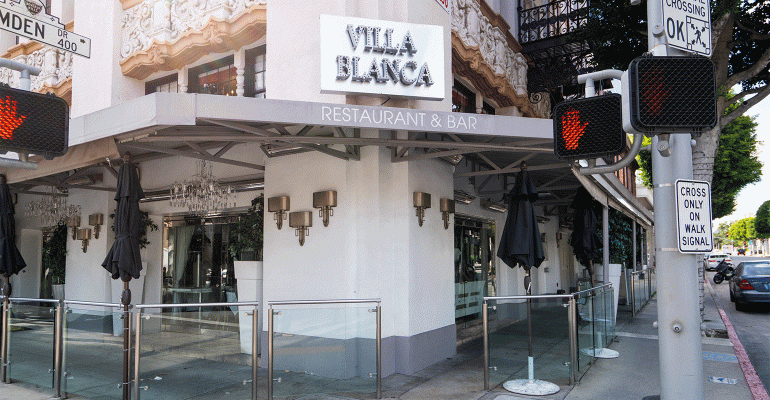Abnormal is the new normal. State and city restrictions to stem the spread of the coronavirus pandemic pushed the restaurant industry into uncharted territory in March. As those efforts stretched into April, the outlook on when and how the industry might emerge remained clouded.
Coronavirus impacts led to a loss of an estimated $25 billion in sales and more than three million jobs in the first three weeks of March, and it continued to see impacts into April.
An estimated 30,000 U.S. restaurants have already closed for good and more than 110,000 were expected to close down in April, according to estimates from the National Restaurant Association.
The remaining restaurants and their customers will likely face a very different world.
In announcing a regional planning effort between California, Oregon and Washington to lift restrictions on businesses in the wake of COVID-19, California Gov. Gavin Newsom acknowledged that the public would see a new normal, saying restaurants that reopen would have more space between tables and seats to accommodate social distancing.
“Normal it will not be,” Newsom said. “At least until we have herd immunity and a vaccine.”
He went on to speculate what changes restaurant operators might have to make.
"You may be having dinner with a waiter wearing gloves, maybe a face mask,” Newsom said at a press conference April 14. “Dinner where the menu is disposable ... where your temperature is checked before you walk in the establishment.”
In the meantime, the timeline for when and how states would emerge from the coronavirus restrictions remained murky.
David Maloni, executive vice president for analytics at ArrowStream, which provides supply-chain technology to the foodservice industry, ranked 15 states that were mostly likely to re-emerge first from the coronavirus restrictions.

The 15 states shaded blue are predicted to reopen soonest, according to ArrowStream data as of April 13. Of those, light blue states are predicted to open soonest, while those shaded darker blue are expected to open later.
Maloni said the ranking factored in coronavirus cases and information from the National Restaurant Association and, as of April 13, it predicted states like North Dakota, Montana and West Virginia would be among the first to reopen. States hit by COVID-19 early, such as Washington and Oregon, were also on the list. Others included were: Alaska, Arizona, Hawaii, Minnesota, New Mexico, Tennessee, Vermont, Utah, Wisconsin and Wyoming.
“We have been watching the situation closely and following the recommendations we’ve been getting from the government as well as the Centers for Disease Control and the local health departments,” said Mazen Albatarseh, CEO of the 56-unit Cotton Patch Café. The Grapevine, Texas-based casual-dining brand recently re-opened three additional restaurants for delivery and curbside pickup, bringing its operating total to 42.
Albatarseh said he had no idea when restaurants re-open their dining rooms. “From a prediction standpoint, I hope it’s sooner rather than later,” he said.
Reopening requires restaurant management weigh the safety and security of their team members and guests with economic survival, Albatarseh said, as well working within local government guidelines.
“COVID-19 will result in some long impacts on our industry,” he added. “Awareness of health, sanitation and food safety will be important on both sides of the counter, both for the employees and the consumers.”
He said operators will be forced to upgrade technology to provide for contactless transactions.
“This pandemic has created new challenges for everyone, and we are all now in various stages of distancing, isolation and quarantine,” said Alex Susskind, the associate dean for academic affairs and director of the Cornell Institute for Food and Beverage Management at the Cornell University School of Hotel Administration, who served as the moderator of the webinar entitled “The Restaurant Business in Crisis: Coping with Restaurant Slowdowns, Expense Management and the Road Ahead.”
“It has affected basically every aspect of our life,” Susskind said, asking the restaurant executives what they saw for the industry as it emerged from the COVID-19 pandemic.
Jeff Chandler, CEO of the 35-unit Austin, Texas-based fast-casual Hopdoddy Burger Bar, said curbside delivery “is here to stay” in restaurants.
“Off-premise will remain a strong component of the business once we get back and fully lean into this new normal,” Chandler said as he joined the other panelists, who included James Park, CEO of Denver-based Garbanzo Mediterranean Fresh, and Jose Dueñas, president and CEO of Coffee & Bagel Brands, parent to the Einstein Bros. Bagels and other brands.
Chandler said one other impact will be that mobile-ordering technology will become commonplace.
“People aren’t going to want to touch a kiosk,” Chandler said, referencing the contagious nature of COVID-19. “They are going to want to order from a person, where they don’t have to touch anything, or through their own mobile device.”

Touchless payment systems are also here to stay, Chandler noted.
“The entrepreneurial, scrappy mentality that we’ve all forced to adapt [to] has been an eye-opener,” Chandler added. “We will all go back and revisit a lot of things: whether we really need to be paying for a conference-call system. … We will just take a more frugal, scrappy approach. We know how thin the margins are in our business anyway.”
Dueñas of Lakewood, Colo.-based Coffee & Bagel Brands, which has 1,100 units of Einstein Bros. Bagels, Bruegger’s Bagels, Caribou Coffee, Noah’s New York Bagels and Manhattan Bagel, said the consumer will come out of the pandemic with a heightened demand for convenience.
“The convenience-driven outlets that the consumer has explored during the crisis will stay and that will change the behavior,” Dueñas said.
He added that restaurant brands will have to make sure they have their product at “arm’s length” for the consumer, be that curbside, delivery, order-ahead or distribution in the grocery channels.
“You have to use your brand to satisfy the convenience needs that will come out of this crisis,” Dueñas said.
The crisis has affected every aspect of the restaurant business, said Park of the 31-unit Garbanzo.
“The big lesson here,” Park said, “is a level of efficiency while maintaining the same level of effectiveness.”
Some of the Garbanzo units, for example, now offer milk, bottled juices and six-packs of eggs to as a consumer service.
While many full-service restaurants had tried to shift to an off-premise model, by mid-April, some were pulling back. Bradenton, Fla.-based First Watch closed all 309 of its company-owned restaurants, with CEO Chris Tomasso saying it was for the health of the non-furloughed staff.

Bradenton, Fla.-based First Watch closed all 309 of its company-owned restaurants, with CEO Chris Tomasso saying it was for the health of the non-furloughed staff.
Worker health also figured into government rescue programs.
Congress passed the “Families First” act to require paid leave for sick workers and those with family members affected by coronavirus and the $2 trillion Coronavirus Aid, Relief and Economic Security, or CARES, Act to provide worker stimulus checks and loan programs for businesses.
The rapid decline in restaurant sales during the second half of March due to the COVID-19 pandemic was enough to push the industry down to its worst month in decades. Same-store sales for restaurants dropped 28.3% in March, according to Black Box Intelligence data from more than 50,000 restaurants and $75 billion in annual sales.
“The 28.3% decline does not show the full impact the virus outbreak is having on restaurants,” Black Box said. “Same-store sales for the industry dropped more than 65% during the last two weeks of the month.”
The sales impact on the restaurant industry, the nation’s largest private sector behind health care, was profound, eclipsing even the massive economic downturn of 2008 and 2009.
“We have reported on restaurant sales and traffic since the last Great Recession, and this is something far beyond anything the industry has experienced,” said Victor Fernandez, vice president of insights and knowledge for Dallas-based Black Box Intelligence.
While some brands looked to boost sales with grocery sales, including big players like Subway and Panera Bread, the industry continued to bleed workers.
U.S. unemployment claims leapt for the third week in a row as the coronavirus pandemic continued to strip jobs from the economy, the U.S. Labor Department said, and restaurant and bar workers were hit especially hard.
Unemployment insurance claims rose 6.6 million for the week ended April 4, bringing the total jobless claims increase for three weeks to about 16.8 million. Eating and drinking place jobs were cut especially deep.
“The restaurant industry experienced its largest one-month employment decline on record in March,” said Bruce Grindy, the National Restaurant Association’s chief economist. “Eating and drinking places — which employ nearly 80% of the total 15.6 million restaurant and foodservice workforce — lost a net 417,000 jobs in March on a seasonally adjusted basis, according to preliminary data from the Bureau of Labor Statistics (BLS). This was more than six times larger than the previous record decline of 67,000 jobs in October 2000.”
While a monthly drop of 417,000 jobs “was truly astounding in historical terms,” Grindy said, “it is only a fraction of the restaurant job losses that will be reported in April.”
The Bureau of Labor Statistic’s April report is scheduled to be released on May 8, and economists expect the restaurant and bar job losses to be in the millions.
“A single-month employment decline of more than 1 million has never happened for the overall U.S. economy in the post-World War II era — let alone a single industry,” Grindy added.
The impact was especially deep at full-service brands, which underwent in-store dining restrictions. While all restaurant transactions were down 36% in the week ending March 22, according to The NPD Group, full-service restaurants suffered a transaction decline of 71%.
Furlough announcements were especially pronounced among casual-dining operators: The Cheesecake Factory furloughed 41,000 hourly workers and was one of a handful of operators to say it was negotiating lease terms and would not be paying April rents.
Some restaurant CEOs, meanwhile, said they would not take salaries during the coronavirus crisis, including leaders at Darden Restaurants Inc., Texas Roadhouse Inc. and Yum Brands Inc.
Other foodservice brands, especially in the quick-service segment, said they would be hiring. Domino’s said it would bring on 10,000 new pizza makers, delivery drivers and customer service representatives. Papa John’s International said it would hire 20,000 workers, and Pizza Hut, a division of Yum, said it would hire 30,000 for call centers, cooks, managers and drivers.
For our most up-to-date coverage, visit the coronavirus homepage.
Contact Ron Ruggless at [email protected]
Follow him on Twitter: @RonRuggless

